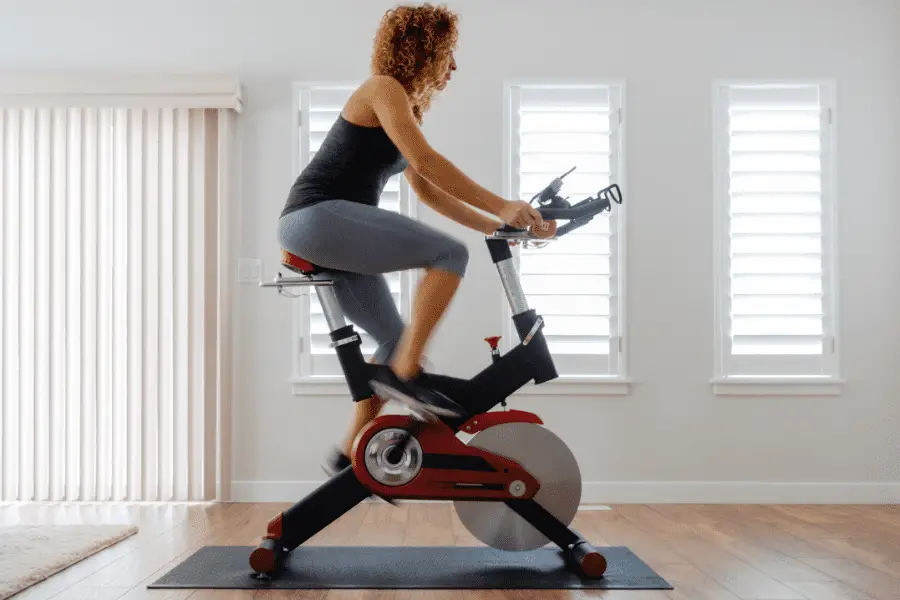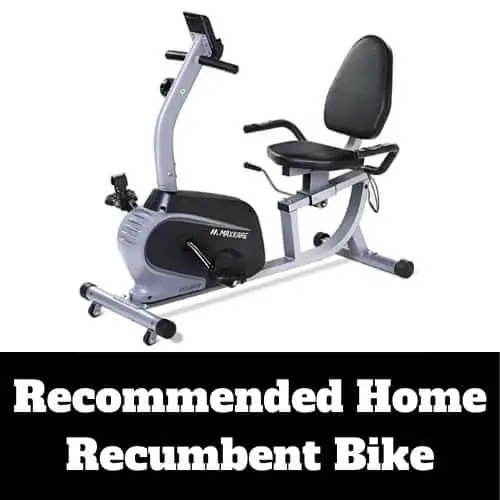Are you wondering if it’s possible to pedal backwards on a recumbent or other exercise bike? You’re not alone. I did some research and here is the answer.
Pedaling backwards on an exercise bike is possible and even has some positive benefits for your body. Pedaling backwards has benefits like better quadriceps activation, higher calorie use and putting less pressure on your knees. Mechanically it’s not a problem and won’t damage your bike.
How does this all work and how can you integrate this into your workout? Find out below.
Contents
Can you pedal backwards on a stationary bike?
Of course you can but the underlying question for most people will be if it’s potentially damaging to your exercise bike or even potentially hurtful to yourself. Those are two different questions and I’ll handle them separately. First let’s look at the mechanical aspect.
Looking for a good recumbent bike? Find out which one I recommend by clicking here.
To understand if you can pedal backwards on an exercise bike, without damaging the machine, it’s good to understand how recumbent and exercise bikes work.
The vast majority of exercise bikes have a flywheel connected to the pedals. Recumbent bikes and upright bikes work in a very similar way. The seating position and build of both bikes are a bit different but the mechanics are so similar that for the questions of pedaling backwards they are the same. So this answer goes for both recumbent and upright bikes.

Both types of bike have pedals and a flywheel. The flywheel does two things;
Make the rotation and operation smoother. A flywheel keeps rotating even if you don’t pedal for a bit. This means the rotation of the machine is smoother and more comfortable. Sure a heavy flywheel requires more energy to start moving but it will release that energy again when you’re not pedaling for a second. This way you can just push for a part of the pedal rotation and keep going.
Can you lose belly fat by only using an exercise bike?
The flywheel is the easiest way to adjust the resistance of an exercise bike. The resistance is usually adjusted with one of two methods;
- Tension band. Often found on older models. This type has a belt between the pedal crank and the flywheel instead of a chain on a road bike. The belt runs through a type of brake. You turn a knob and the brake clamps down on the belt tighter therefore increasing the resistance.
- Magnetic resistance. This type is more modern and uses electromagnets. Magnets can attract or repel each other. Electromagnets can change in ‘strength’ by running more or less current through it. The edge of the flywheel is magnetic and there’s an electromagnet fixed to the bike. With a button or knob you can increase the ‘strength’ of the magnet and increase the resistance.
Both types of resistance are suitable to be used backwards. There are no mechanical problems that will arise from pedaling backwards. The pedals are connected to the flywheel. There is no problem if you rotate them the other way. From a resistance perspective there is no problem either. Both the tension band and magnetic resistance type have no issue with working the opposite way. Think about the brakes on your car, do they have a problem working in reverse? No they don’t. And magnets really don’t care.
Is 30 minutes on an exercise bike enough to see results?
There might even be some benefits to pedaling backwards.
What is the benefit of pedaling backwards?
Most people just pedal forward. That makes perfect sense since it’s the most natural thing to do. Everyone that has every learned to ride a bike will automatically pedal forward since that’s how you move on a bike. Pedaling backwards on a road bike doesn’t get you anywhere.
On an exercise bike you’re not going anywhere anyways so that opens up some different opportunities. So are there any benefits to rotating the other way?
The American Council on Exercise (ACE) has done some research on the effects of pedaling backwards.
researchers recruited 16 apparently healthy volunteers—eight male and eight female—for two separate studies. The participants completed six five-minute submaximal exercise bouts, three while pedaling forward and three while pedaling backward. Half of the subjects pedaled forward first, then backward, while the other half did the opposite.
https://www.acefitness.org/education-and-resources/professional/prosource/june-2015/5401/ace-sponsored-research-evaluates-the-effectiveness-of-pedaling-backward
The study revealed that pedaling backward on the Cascade cycle elicited higher heart-rate and energy-cost values than when pedaling at identical workloads in the forward direction. The increase in physiological response was associated with higher muscle activation of the quadriceps muscles, which was consistent with the subject’s description of feeling like they had to “pull” the pedals when cycling. The concept of specificity indicates that pedaling forward should still make up the vast majority of a cyclist’s training, but the subtle differences in muscle activation observed when pedaling backward may offer some functional benefits.
https://www.acefitness.org/about-ace/press-room/press-releases/5448/new-study-evaluates-whether-pedaling-backward-boosts-cycling-performance
So as you can see from that quote the most important differences are that it costs more energy to rotate the pedals with the same resistance. This results in a higher heart-rate and more used calories. Most of the extra energy seems to be used in the quadriceps.
The extra load on the quadriceps can potentially translate into better performance when pedaling forwards. Combined with the cardiovascular benefits it can be really worth pedaling backwards sometimes.
It can also be used for knee problems. Since you’re more pulling the pedals than pushing, there is less compression on the knee joint which can help prevent and/or recover knee problems.
You can find the full study here (click)
So pedaling backwards does the following things;
- Use more energy as pedaling forward at the same resistance.
- Cause a higher heart rate.
- Activate your quadriceps more
- Puts less stress on your knee joints
If you’re training to ride a bike on the street, the majority of your training should still be forward since that’s the movement you’re actually doing there. Pedaling backwards is certainly a good supplemental exercise that can help you increase your performance.
If you’re not training for riding a bike on the street, it’s still a good idea to pedal in both directions. Both ways of working out can complement each other and make you stronger, better and healthier. A combination of the two will yield balanced results.
Looking for a good recumbent bike with plenty of options and 20 levels of magnetic resistance? My favorite bike for home use has all of that. Click here to find it.
Related questions
How much weight can a recumbent bike handle? The average recumbent bike for home use as a weight limit of 300 lbs. There are a few models that handle more weight and a few can handle less but the vast majority are built to handle 300 lbs. Consult your user manual to find out what your bikes user weight limit is.
Click here to find out more details
Which muscles does a recumbent bike work? Exercising on a recumbent bike will mainly work your;
- Quadriceps
- Glutes
- Hamstrings
As well as abs, calves, and other stabilizing muscles to a lesser degree.
Favorite Cardio Accessories
Check out these accessories that improve a home cardio workout:
- Equipment mat: All cardio equipment should be put on an equipment mat. The Rubber-Cal mat (Amazon) is an affordable yet very high-quality choice.
- Interval timer: To time your intervals and workouts, there is no better choice than the GymNext Flex. It’s super easy to use and set up with a phone app.
- Tablet holder: Cardio can be boring. With this tablet holder (Amazon) you can follow along with on-demand workouts or just watch a movie on any cardio machine.
- Heart rate monitor: Monitoring your heart rate is very important while doing cardio. The Polar H10 (Amazon) connects to almost anything you can imagine and is very accurate.
To find which cardio machines I recommend for home gyms, click here.


